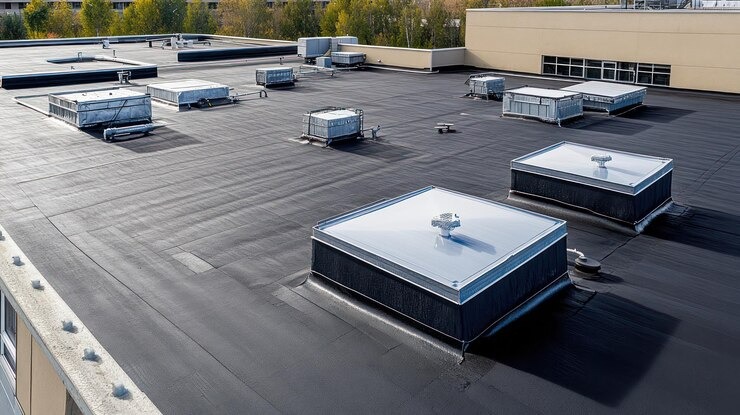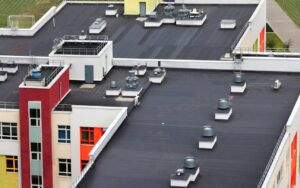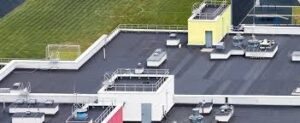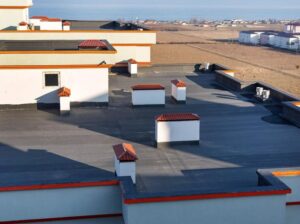RoofCont provides expert roofing, siding and contractor services, specializing in installations, repairs, and replacements for residential and commercial properties.
RoofCont provides expert roofing, siding and contractor services, specializing in installations, repairs, and replacements for residential and commercial properties.

Flat roofs commonly used in the industrial and commercial setting, are similar to the flat roofs in residential construction. This article is a guide to commercial flat roofing and it discusses the various types of commercial flat roofing, the advantages of commercial flat roofing, the types of roofing materials to be used, and some important points of roof repair and maintenance.
Low-slope or nearly horizontal roof surface is the characteristic of a commercial flat roof system. Flat roofing system, as contrasted to sloped roofs, requires the use and application of special roofing materials and roofing skills to guarantee adequate drainage and avoidance of ponding of collected water. The major objective of a commercial roofing system is to safeguard the commercial building against weather conditions. The roof system that is put in considers the type of roof system a lot as far as the long term protection of the building and flat roof performance is concerned.

There are a wide variety of benefits associated with flat roof systems when it comes to commercial buildings which range as far as cost effective, easy to install and so on. The smooth surface also enables the occupancy of HVAC units as well as other equipment which uses the maximum space. Maintenance and repairs are easy as well through flat roofs. Selecting a proper commercial flat roofing system can be very important in the buildings in terms of energy efficiency where costs used in heating and cooling a building are minimized. Flat roofing technology is very versatile and sensible to meet many commercial roofing requirements.
There are many kinds of commercial flat roofs materials which have their pros and cons. Typical examples are EPDM roofing membrane (rubber roofing), TPO roofing, PVC roofing, modified bitumen roofing and built-up roofing (BUR systems). There are also metal roof alternatives. Every roofing material has varying degrees of durability, cost and ease of repair. The more suitable commercial flat roofing system turns on the requirements and the budget of a particular building. Knowledge of these options will determine the type of membrane roof to be planted and the effectiveness of the roof to take longer before it wears out.
The landscape of commercial flat roofs offers a variety of unique categories, each meant to be adapted to the architectural requirements and climatical conditions. The commercial flat roofing options are discussed in a comprehensive guide to explain these options such as single ply membranes like EPDM roofing, TPO roofing, and PVC roofing. Modified bitumen and built-up roofing (BUR systems) are other common options too, which provide various degrees of durability and affordability. To choose the most appropriate commercial flat roofing system, it is important to consider such factors as climate, use of the building and the budget. The roof type selected has huge implications on future performance, as well as the maintenance needs.
Rubber roofing, which is an EPDM roofing, is a single-ply roofing technique that has been hailed because of its flexibility and durability. EPDM roofing membranes are a common kind of roof and show high resistance to the process of weathering and UV radiations. Some of the advantages are fairly low cost and easy installation. EPDM roofs are however prone to puncture, and may need more frequent repairs than others available. Whether EPDM roof is the most appropriate commercial flat roofing solution or not depends on the building specificities and the budgets. It is significant to select the right kind of roof.
Roofing is tough and chemically resistant. PVC is a single-ply roofing membrane and it provides a perfect protection against severe chemicals, so it is applicable to industrial premises. Roofing is also very reflective thereby making it energy efficient as far as cooling costs are concerned. The cost requirement might be a bit expzyzOverall in the long-term, it is cost-effective due to its durability and resistance to puncture. The choice of a PVC roofing is made in line with the building chemical exposure requirements and energy efficiency objectives, as well as the kind of roof required.
Roofing is actually such type of roofing membrane which is a single ply and is characterized by its performance to cost ratio. TPO is UV resistant, puncture resistant, and chemical resistant, thus it can be used in many different commercial buildings. Although TPO roofing is largely cheaper as compared to PVC, it might not present the same chemical resistance as PVC. When using TPO as the most practical commercial flat roofing line of business, it is important to assess the exact performance needs of the flat roof and the available budget allocation. As a rule, TPO is less costly.
Built-up roofing (BUR systems) is another old form of roof which is constructed by several layers of roofing felt and bitumen to provide a sturdy and water proof surface. BUR systems are very resistant to water and foot traffic. It is however, labor intensive to install and heavier than single ply membranes. Built-up roofing itself is also a good roofing option on buildings which need strong structure and durability. The option of having a built up type of roof offers more levels of protection.
In the case of modified bitumen roofing, we have a sort of hybrid roofing, a system that has managed to blend the old and new with the help of polymer technology. The modified bitumen roofing is flexible and more durable than the conventional BUR systems. It can also be bought in different application types such as torch applied or self adhered. The modified bitumen is quite an adaptable option as a new roof as well as roof repair. The roof is extremely widespread.

The lifespan of a commercial flat roof is influenced by the type of roof materials used, the quality of installation, and the level of ongoing maintenance. Environmental conditions, such as extreme temperatures and UV exposure, can also significantly impact the roof membrane’s longevity. Regular inspections and timely repair of any damage are crucial for extending the life of a flat roof system. Choosing durable roofing materials and adhering to proper installation practices is essential for maximizing the lifespan of the roof. Proper maintenance is very important.
The average lifespan of different commercial flat roof types varies considerably. EPDM roofs typically last between 20 to 30 years, while TPO and PVC roofing systems can offer a lifespan of 20 to 35 years. Built-up roofing (BUR systems) and modified bitumen roofing generally provide a lifespan of 15 to 25 years. These figures are estimates, and the actual lifespan can be influenced by the factors previously mentioned. Regular inspections by roofing experts and proactive maintenance are key to achieving the full potential lifespan of the flat roof.
Extending the lifespan of a commercial flat roof system requires a proactive approach to maintenance. Regular inspections should be conducted to identify and address any potential issues, such as ponding water, damaged seams, or punctures. Cleaning the roof surface to remove debris and prevent the growth of moss or algae is also essential. Prompt repair of any damage, no matter how minor, can prevent further deterioration and prolong the life of the roof system. Consulting with a qualified roofing contractor for regular maintenance and repair services is highly recommended, which ensures the roof’s longevity.
Commercial flat roof systems, while durable, are susceptible to a range of issues that can compromise their integrity. Ponding water, caused by inadequate drainage, is a common problem, leading to premature deterioration of the roof membrane and potential leaks. The types of commercial flat roofs can also face damage from extreme weather, such as hail, high winds, and UV radiation. Regular inspections are essential for identifying and addressing these issues promptly. Selecting the appropriate roofing materials can help mitigate these risks. Proper maintenance is key to a long-lasting commercial roofing system.
Recognizing the signs that your commercial flat roof requires repair is crucial for preventing extensive damage. Obvious signs include visible leaks, cracks, or blisters on the roof surface. Ponding water that persists for more than 48 hours after rainfall is another indication of drainage problems. Other signs may include increased energy bills, which could indicate insulation damage, or discoloration of the roof membrane. Promptly addressing these issues can prevent costly damage and extend the lifespan of the flat roof.
Selecting the right roofing company for commercial flat roof repair is essential for ensuring quality workmanship and lasting results. Look for a roofing contractor with extensive experience in commercial roofing systems, particularly flat roofs. Check for proper licensing, insurance, and certifications. Request references and review online testimonials to assess the company’s reputation. Obtain multiple bids and compare them carefully, considering not only the price but also the scope of work and the quality of the roofing materials used. A reputable roofing company will provide a detailed assessment of the damage and a clear plan for the repair.
The cost of commercial flat roof repair can vary significantly depending on the extent of the damage, the type of roof, and the roofing materials required. Minor repairs, such as patching small leaks or replacing damaged flashing, may be relatively inexpensive. More extensive repairs, such as replacing large sections of the roof membrane or addressing structural issues, can be significantly more costly. Obtaining multiple bids from qualified roofing companies is essential for comparing prices and ensuring a fair estimate. Consider the long-term cost-effectiveness of different repair options and prioritize quality workmanship to prevent future problems.

Roof restoration is a cost-effective alternative to roof replacement that can extend the life of a commercial flat roof system. Consider roof restoration when the roof membrane is showing signs of wear and tear but is not severely damaged. Common indicators include minor leaks, surface cracks, and a faded or weathered roof surface. Restoration typically involves cleaning the existing roof, repairing any damage. And applying a protective coating to create a seamless, waterproof layer. Roof restoration can improve energy efficiency, reduce maintenance costs, and extend the life of the building’s roof.
Roof restoration offers numerous benefits for commercial building owners. It is significantly less expensive than roof replacement, minimizing disruption to business operations. Restoration can improve the energy efficiency of the building by reflecting sunlight and reducing heat absorption. It also extends the lifespan of the existing roof, postponing the need for a costly replacement. A properly restored roof provides a seamless, waterproof barrier, protecting the building from leaks and water damage. Consider this choice when you need a type of roof fix.
Deciding whether to repair or replace a commercial flat roof requires careful consideration of several factors. If the roof is severely damaged, nearing the end of its lifespan, or has extensive structural problems, replacement may be the only viable option. However, if the damage is limited and the roof is still in relatively good condition, repair or restoration may be a more cost-effective solution. Consulting with a qualified roofing contractor is essential for assessing the condition of the roof and determining the best course of action. The best commercial flat roofing solution is the one that is best for your situation.
Deprecated: File Theme without comments.php is deprecated since version 3.0.0 with no alternative available. Please include a comments.php template in your theme. in /home/u737183660/domains/roofcont.com/public_html/blog/wp-includes/functions.php on line 6131